Experimental Analysis of Sound Propagation and Room Acoustics in Airport Terminal Piers
Abstract
1. Introduction
2. Methodology
2.1. Measurement Sites in Pier-Style Departure Lounges
2.2. Acoustic Materials in Pier-Style Departure Lounges
2.3. Impulse Response Measurement Method
2.4. Sound Pressure Level Measurement Method
3. Results
3.1. Impulse Response Results Within the Departure Lounge
3.2. Room Acoustic Parameters Within the Departure Lounge
4. Discussion
4.1. Sound Attenuation Within the Departure Lounge
4.2. Variation in Reverberation Time with the Distance Between Receiver Points and the Sound Source
4.3. Relationship Between Reverberation Time and Cross-Sectional Area in the Departure Lounge
4.4. Changes in Clarity with Increasing Distance from the Sound Source
5. Conclusions
Author Contributions
Funding
Data Availability Statement
Conflicts of Interest
Appendix A
| Instrument | Model | Key Specifications (Typical from Datasheets) |
|---|---|---|
| Dirac Room Acoustics Software | B&K 7841 Dirac 5.0 | Compliant with ISO 3382 (room acoustics), ISO 18233 (analysis methods) and IEC 60268-16 (speech intelligibility) |
| USB Audio Interface | B&K ZE 0948 | A dedicated calibration procedure allows accurate compensation for the gain (or attenuation) presented by the high-quality sound card. |
| Power Amplifier | B&K 2716 | Output is approx. 300 W and is relatively independent of load. |
| Omnidirectional Loudspeaker (Dodecahedron) | B&K 4292 | Type 4292-L uses 12 loudspeakers in a dodecahedral configuration to radiate sound evenly with a spherical distribution. |
| Omnidirectional Measurement Microphone | B&K 4189 | Frequency: 1 Hz to 180 kHzDynamic Range: 6.5 dB to 192 dB |
| Conditioning Amplifier | B&K 2690 Nexus | High input signal range, low noise, and extensive overload facilities. |
| Sound Level Meter | B&K 2250 | Wide frequency ranges from 5.6 Hz to 20 kHzA-weighted dynamic range of 16.4 dB to 140 dB |
Appendix B. Acoustical Characteristics in Pier A
| Receiver Points | R1 | R2 | R3 | R4 | R5 | R6 | R7 | R8 | R9 | R10 |
| The source–receiver propagation distance (m) | 9.00 | 15.00 | 27.00 | 29.55 | 45.00 | 46.58 | 62.97 | 80.00 | 81.73 | 64.13 |
| STI | 0.46 | 0.45 | 0.43 | 0.35 | 0.4 | 0.31 | 0.4 | 0.35 | 0.26 | 0.28 |
| LAeq (dBA) | 91.07 | 83.97 | 83.50 | 80.25 | 79.84 | 78.51 | 77.59 | 76.37 | 71.63 | 75.42 |
| Receiver Points | R11 | R12 | R13 | R14 | R15 | R16 | R17 | R18 | R19 | R20 |
| The source–receiver propagation distance (m) | 9.03 | 12.00 | 27.00 | 21.64 | 45.00 | 37.95 | 46.57 | 62.58 | 72.64 | 66.37 |
| STI | 0.45 | 0.46 | 0.41 | 0.42 | 0.42 | 0.36 | 0.27 | 0.26 | 0.24 | 0.33 |
| LAeq (dBA) | 86.88 | 86.9 | 83.41 | 81.43 | 81.1 | 79.95 | 79.01 | 73.83 | 70.85 | 76.01 |
| EDT (s) | 125 Hz | 250 Hz | 500 Hz | 1000 Hz | 2000 Hz | 4000 Hz | Average (500–1000 Hz) |
| R1 | 1.43 | 2.16 | 2.68 | 2.59 | 2.80 | 2.39 | 2.63 |
| R2 | 1.78 | 2.66 | 3.23 | 3.29 | 3.41 | 2.60 | 3.26 |
| R3 | 1.52 | 2.23 | 3.04 | 2.94 | 3.15 | 2.50 | 2.99 |
| R4 | 2.40 | 3.13 | 3.93 | 4.04 | 3.99 | 3.14 | 3.98 |
| R5 | 1.75 | 3.08 | 3.43 | 3.50 | 3.64 | 2.76 | 3.46 |
| R6 | 2.32 | 2.67 | 3.90 | 3.99 | 4.06 | 3.15 | 3.95 |
| R7 | 2.46 | 2.90 | 4.54 | 4.27 | 4.25 | 3.15 | 4.41 |
| R8 | 1.96 | 3.57 | 4.42 | 4.63 | 4.52 | 3.29 | 4.52 |
| R9 | 1.98 | 3.32 | 5.06 | 4.75 | 4.67 | 3.83 | 4.91 |
| R10 | 2.91 | 3.42 | 4.31 | 4.85 | 4.66 | 3.72 | 4.58 |
| R11 | 1.68 | 2.38 | 2.32 | 2.24 | 2.68 | 2.16 | 2.28 |
| R12 | 2.21 | 2.42 | 3.17 | 2.95 | 3.07 | 2.10 | 3.06 |
| R13 | 1.47 | 2.25 | 3.16 | 2.91 | 3.20 | 2.55 | 3.03 |
| R14 | 1.47 | 2.59 | 3.61 | 3.40 | 3.16 | 2.49 | 3.50 |
| R15 | 2.01 | 2.44 | 3.34 | 3.20 | 3.60 | 2.65 | 3.27 |
| R16 | 1.51 | 2.73 | 3.83 | 3.85 | 3.84 | 3.05 | 3.84 |
| R17 | 2.49 | 3.13 | 4.23 | 4.39 | 4.06 | 3.42 | 4.31 |
| R18 | 2.61 | 3.45 | 4.71 | 4.71 | 4.58 | 3.58 | 4.71 |
| R19 | 2.29 | 3.83 | 4.74 | 5.09 | 4.90 | 3.94 | 4.92 |
| R20 | 2.51 | 3.22 | 4.08 | 4.04 | 4.11 | 3.20 | 4.06 |
| T30 (s) | 125 Hz | 250 Hz | 500 Hz | 1000 Hz | 2000 Hz | 4000 Hz | Average (500–1000 Hz) |
| R1 | 2.72 | 3.29 | 4.06 | 3.80 | 3.60 | 2.73 | 3.93 |
| R2 | 2.44 | 3.30 | 3.84 | 3.94 | 3.86 | 3.02 | 3.89 |
| R3 | 2.50 | 3.09 | 3.80 | 3.81 | 3.66 | 2.79 | 3.80 |
| R4 | 2.44 | 3.33 | 3.86 | 3.95 | 3.82 | 3.08 | 3.90 |
| R5 | 2.37 | 3.21 | 4.27 | 4.18 | 3.90 | 2.96 | 4.23 |
| R6 | 2.35 | 3.17 | 3.47 | 3.52 | 3.83 | 2.98 | 3.49 |
| R7 | 2.31 | 3.79 | 3.66 | 3.85 | 3.85 | 3.19 | 3.76 |
| R8 | 2.86 | 3.48 | 4.72 | 3.96 | 4.30 | 3.41 | 4.34 |
| R9 | 2.81 | 3.61 | 4.59 | 4.60 | 4.23 | 3.35 | 4.59 |
| R10 | 2.29 | 3.25 | 3.66 | 3.70 | 3.70 | 3.21 | 3.68 |
| R11 | 2.13 | 3.04 | 4.33 | 3.31 | 3.37 | 2.16 | 3.82 |
| R12 | 2.31 | 3.20 | 3.69 | 3.64 | 3.71 | 2.95 | 3.66 |
| R13 | 2.46 | 3.13 | 3.67 | 3.92 | 3.69 | 2.81 | 3.80 |
| R14 | 2.39 | 3.22 | 3.82 | 3.89 | 3.69 | 2.89 | 3.85 |
| R15 | 2.38 | 3.22 | 3.90 | 3.85 | 3.77 | 2.98 | 3.87 |
| R16 | 2.63 | 3.34 | 3.81 | 3.76 | 3.75 | 3.04 | 3.78 |
| R17 | 2.66 | 3.47 | 4.00 | 3.94 | 3.73 | 2.90 | 3.97 |
| R18 | 2.81 | 3.62 | 4.29 | 3.83 | 3.83 | 3.18 | 4.06 |
| R19 | 2.82 | 3.68 | 4.38 | 4.41 | 4.16 | 3.39 | 4.40 |
| R20 | 3.01 | 2.92 | 3.46 | 4.32 | 4.04 | 3.15 | 3.89 |
| D50 | 125 Hz | 250 Hz | 500 Hz | 1000 Hz | 2000 Hz | 4000 Hz | Average (500–4000 Hz) |
| R1 | 0.54 | 0.32 | 0.38 | 0.45 | 0.41 | 0.43 | 0.42 |
| R2 | 0.59 | 0.37 | 0.23 | 0.41 | 0.38 | 0.38 | 0.35 |
| R3 | 0.39 | 0.39 | 0.3 | 0.26 | 0.23 | 0.29 | 0.27 |
| R4 | 0.39 | 0.35 | 0.13 | 0.1 | 0.23 | 0.27 | 0.18 |
| R5 | 0.12 | 0.42 | 0.19 | 0.25 | 0.16 | 0.3 | 0.23 |
| R6 | 0.31 | 0.26 | 0.11 | 0.08 | 0.1 | 0.23 | 0.13 |
| R7 | 0.17 | 0.27 | 0.29 | 0.27 | 0.28 | 0.34 | 0.30 |
| R8 | 0.12 | 0.25 | 0.17 | 0.27 | 0.17 | 0.3 | 0.23 |
| R9 | 0.07 | 0.11 | 0.12 | 0.04 | 0.03 | 0.06 | 0.06 |
| R10 | 0.11 | 0.2 | 0.15 | 0.06 | 0.05 | 0.07 | 0.08 |
| R11 | 0.5 | 0.33 | 0.31 | 0.41 | 0.39 | 0.46 | 0.39 |
| R12 | 0.62 | 0.43 | 0.24 | 0.32 | 0.42 | 0.52 | 0.38 |
| R13 | 0.33 | 0.24 | 0.31 | 0.2 | 0.16 | 0.29 | 0.24 |
| R14 | 0.56 | 0.25 | 0.22 | 0.22 | 0.24 | 0.28 | 0.24 |
| R15 | 0.1 | 0.38 | 0.24 | 0.17 | 0.18 | 0.25 | 0.21 |
| R16 | 0.31 | 0.11 | 0.12 | 0.12 | 0.17 | 0.33 | 0.19 |
| R17 | 0.08 | 0.21 | 0.1 | 0.06 | 0.07 | 0.13 | 0.09 |
| R18 | 0.03 | 0.12 | 0.11 | 0.03 | 0.03 | 0.04 | 0.05 |
| R19 | 0.02 | 0.04 | 0.03 | 0.01 | 0.01 | 0.02 | 0.02 |
| R20 | 0.13 | 0.13 | 0.12 | 0.24 | 0.17 | 0.24 | 0.19 |
Appendix C. Acoustical Characteristics in Pier B
| Receiver Points | R1 | R2 | R3 | R4 | R5 | R6 | R7 | R8 | R9 | R10 |
| The source–receiver propagation distance (m) | 11.34 | 11.28 | 27.97 | 45.70 | 54.59 | 36.75 | 19.68 | 8.00 | 18.00 | 36.00 |
| STI | 0.54 | 0.55 | 0.43 | 0.38 | 0.31 | 0.36 | 0.44 | 0.53 | 0.47 | 0.45 |
| LAeq (dBA) | 89.80 | 92.30 | 86.60 | 84.50 | 82.70 | 83.30 | 86.03 | 88.00 | 87.30 | 84.70 |
| Receiver Points | R11 | R12 | R13 | R14 | R15 | R16 | ||||
| The source–receiver propagation distance (m) | 54.00 | 72.00 | 85.56 | 85.89 | 72.44 | 54.65 | ||||
| STI | 0.41 | 0.38 | 0.34 | 0.29 | 0.34 | 0.29 | ||||
| LAeq (dBA) | 80.40 | 77.90 | 74.90 | 72.90 | 75.80 | 77.40 |
| EDT (s) | 125 Hz | 250 Hz | 500 Hz | 1000 Hz | 2000 Hz | 4000 Hz | Average (500–1000 Hz) |
| R1 | 1.50 | 1.92 | 2.58 | 2.15 | 2.44 | 1.93 | 2.37 |
| R2 | 1.81 | 1.87 | 2.43 | 2.45 | 2.34 | 1.98 | 2.44 |
| R3 | 2.63 | 2.64 | 3.24 | 3.89 | 3.26 | 2.53 | 3.57 |
| R4 | 2.31 | 2.97 | 3.79 | 3.77 | 3.58 | 2.76 | 3.78 |
| R5 | 1.98 | 3.19 | 3.85 | 3.95 | 3.80 | 2.91 | 3.90 |
| R6 | 2.10 | 3.08 | 3.80 | 3.87 | 3.61 | 2.69 | 3.84 |
| R7 | 2.09 | 2.60 | 3.37 | 2.99 | 3.13 | 2.20 | 3.18 |
| R8 | 1.63 | 2.38 | 2.90 | 2.50 | 2.57 | 2.05 | 2.70 |
| R9 | 1.65 | 2.28 | 3.24 | 2.99 | 3.06 | 2.22 | 3.12 |
| R10 | 1.83 | 2.67 | 3.36 | 3.55 | 3.37 | 2.44 | 3.46 |
| R11 | 2.50 | 3.23 | 3.60 | 4.02 | 3.96 | 2.92 | 3.81 |
| R12 | 2.94 | 3.48 | 3.95 | 4.22 | 4.17 | 3.23 | 4.08 |
| R13 | 2.88 | 3.74 | 4.62 | 4.70 | 4.68 | 3.70 | 4.66 |
| R14 | 3.37 | 3.57 | 4.67 | 4.83 | 4.69 | 3.73 | 4.75 |
| R15 | 2.79 | 3.49 | 3.93 | 4.37 | 4.22 | 3.37 | 4.15 |
| R16 | 2.88 | 3.15 | 4.25 | 4.22 | 4.19 | 3.31 | 4.24 |
| T30 (s) | 125 Hz | 250 Hz | 500 Hz | 1000 Hz | 2000 Hz | 4000 Hz | Average (500–1000 Hz) |
| R1 | 2.25 | 2.82 | 3.54 | 3.32 | 3.35 | 2.43 | 3.43 |
| R2 | 2.58 | 2.74 | 2.78 | 3.09 | 3.16 | 2.28 | 2.93 |
| R3 | 2.23 | 2.89 | 3.46 | 3.51 | 3.44 | 2.73 | 3.49 |
| R4 | 2.41 | 3.10 | 3.53 | 3.48 | 3.37 | 2.75 | 3.50 |
| R5 | 2.47 | 3.09 | 3.61 | 3.52 | 3.48 | 2.83 | 3.56 |
| R6 | 2.18 | 3.05 | 3.59 | 3.45 | 3.38 | 2.77 | 3.52 |
| R7 | 2.35 | 2.78 | 3.40 | 3.55 | 3.32 | 2.61 | 3.47 |
| R8 | 2.14 | 2.90 | 3.44 | 3.38 | 3.14 | 2.47 | 3.41 |
| R9 | 2.39 | 3.13 | 3.67 | 3.54 | 3.49 | 2.77 | 3.60 |
| R10 | 2.50 | 3.08 | 3.60 | 3.58 | 3.49 | 2.84 | 3.59 |
| R11 | 2.63 | 3.21 | 3.97 | 3.70 | 3.79 | 3.01 | 3.83 |
| R12 | 2.39 | 3.29 | 3.92 | 4.01 | 3.88 | 3.18 | 3.97 |
| R13 | 2.67 | 3.54 | 4.03 | 4.19 | 4.25 | 3.45 | 4.11 |
| R14 | 2.71 | 3.58 | 4.17 | 4.24 | 4.43 | 3.45 | 4.20 |
| R15 | 2.71 | 3.39 | 4.08 | 4.12 | 3.91 | 3.25 | 4.10 |
| R16 | 2.62 | 3.49 | 3.83 | 3.95 | 3.84 | 3.22 | 3.89 |
| D50 | 125 Hz | 250 Hz | 500 Hz | 1000 Hz | 2000 Hz | 4000 Hz | Average (500–4000 Hz) |
| R1 | 0.73 | 0.57 | 0.37 | 0.60 | 0.44 | 0.64 | 0.51 |
| R2 | 0.76 | 0.57 | 0.35 | 0.65 | 0.45 | 0.72 | 0.54 |
| R3 | 0.53 | 0.23 | 0.43 | 0.27 | 0.25 | 0.33 | 0.32 |
| R4 | 0.29 | 0.34 | 0.25 | 0.18 | 0.22 | 0.30 | 0.24 |
| R5 | 0.19 | 0.17 | 0.11 | 0.09 | 0.10 | 0.15 | 0.11 |
| R6 | 0.40 | 0.28 | 0.11 | 0.11 | 0.12 | 0.20 | 0.14 |
| R7 | 0.60 | 0.36 | 0.19 | 0.30 | 0.35 | 0.38 | 0.31 |
| R8 | 0.60 | 0.30 | 0.49 | 0.55 | 0.46 | 0.58 | 0.52 |
| R9 | 0.47 | 0.50 | 0.33 | 0.25 | 0.35 | 0.36 | 0.32 |
| R10 | 0.50 | 0.38 | 0.31 | 0.25 | 0.38 | 0.39 | 0.33 |
| R11 | 0.53 | 0.34 | 0.31 | 0.30 | 0.24 | 0.32 | 0.29 |
| R12 | 0.21 | 0.29 | 0.32 | 0.22 | 0.18 | 0.26 | 0.25 |
| R13 | 0.22 | 0.28 | 0.27 | 0.16 | 0.14 | 0.22 | 0.20 |
| R14 | 0.16 | 0.17 | 0.11 | 0.05 | 0.04 | 0.06 | 0.07 |
| R15 | 0.20 | 0.19 | 0.12 | 0.12 | 0.11 | 0.16 | 0.13 |
| R16 | 0.16 | 0.13 | 0.08 | 0.08 | 0.06 | 0.08 | 0.08 |
References
- Edwards, B. The Modern Airport Terminal: New Approaches to Airport Architecture; Taylor & Francis: London, UK, 2004. [Google Scholar]
- Kazda, A.; Caves, R.E. Airport Design and Operation; Emerald Group Publishing Limited: Leeds, UK, 2010. [Google Scholar]
- Bandara, S.S. Wirasinghe, Optimum geometries for pier-type airport terminals. J. Transp. Eng. 1992, 118, 187–206. [Google Scholar] [CrossRef]
- Bandara, S.S. Wirasinghe, Walking distance minimization for airport terminal configurations. Transp. Res. Part A Policy Pract. 1992, 26, 59–74. [Google Scholar] [CrossRef]
- Hanaoka, S.; Saraswati, B. Low cost airport terminal locations and configurations. J. Air Transp. Manag. 2011, 17, 314–319. [Google Scholar] [CrossRef]
- Liu, J.C.-C.; Lu, P.-C. Sound field prediction in long enclosures with branches: A combined method. Appl. Acoust. 2010, 71, 306–314. [Google Scholar] [CrossRef]
- Li, K.M.; Iu, K.K. Propagation of sound in long enclosures. J. Acoust. Soc. Am. 2004, 116, 2759–2770. [Google Scholar] [CrossRef]
- Nowicka, E. Initial acoustic assessment of long underground enclosures for designers. Tunn. Undergr. Space Technol. 2020, 105, 103577. [Google Scholar] [CrossRef]
- Picaut, J.; Simon, L.; Polack, J.D. Sound field in long rooms with diffusely reflecting boundaries. Appl. Acoust. 1999, 56, 217–240. [Google Scholar] [CrossRef]
- Jing, Y.; Larsen, E.W.; Xiang, N. One-dimensional transport equation models for sound energy propagation in long spaces: Theory. J. Acoust. Soc. Am. 2010, 127, 2312–2322. [Google Scholar] [CrossRef]
- Redmore, T.L. A method to predict the transmission of sound through corridors. Appl. Acoust. 1982, 15, 133–146. [Google Scholar] [CrossRef]
- Davies, H.G. Noise propagation in corridors. J. Acoust. Soc. Am. 1973, 53, 1253–1262. [Google Scholar] [CrossRef]
- Yamamoto, T. On the distribution of sound in a corridor. J. Acoust. Soc. Jpn. 1961, 17, 286–292. [Google Scholar]
- Imaizumi, H.; Kunimatsu, S.; Isei, T. Sound propagation and speech transmission in a branching underground tunnel. J. Acoust. Soc. Am. 2000, 108, 632–642. [Google Scholar] [CrossRef] [PubMed]
- Li, K.M.; Iu, K.K. Full-scale measurements for noise transmission in tunnels. J. Acoust. Soc. Am. 2005, 117, 1138–1145. [Google Scholar] [CrossRef]
- Shimokura, R.; Soeta, Y. Sound field characteristics of underground railway stations—Effect of interior materials and noise source positions. Appl. Acoust. 2012, 73, 1150–1158. [Google Scholar] [CrossRef]
- Zhao, W.; Zhu, X.; Kang, J.; Xu, H. Sound field of subway platforms with complex forms. Tunn. Undergr. Space Technol. 2024, 147, 105701. [Google Scholar] [CrossRef]
- Law, M.K.; Li, K.M.; Leung, C.W. Noise reduction in tunnels by hard rough surfaces. J. Acoust. Soc. Am. 2008, 124, 961–972. [Google Scholar] [CrossRef]
- Geng, Y.; Yu, J.; Lin, B.; Wang, Z.; Huang, Y. Impact of individual IEQ factors on passengers’ overall satisfaction in Chinese airport terminals. Build. Environ. 2017, 112, 241–249. [Google Scholar] [CrossRef]
- van Wijngaarden, S.J.; Atsma, R. Ambient noise inside airport terminals: A detailed survey of the background noise at Amsterdam Airport Schiphol. In INTER-NOISE and NOISE-CON Congress and Conference Proceedings; Institute of Noise Control Engineering: Grand Rapids, MA, USA, 2020; pp. 1588–1595. [Google Scholar]
- Wang, Z.; Zhao, H.; Lin, B.; Zhu, Y.; Ouyang, Q.; Yu, J. Investigation of indoor environment quality of Chinese large-hub airport terminal buildings through longitudinal field measurement and subjective survey. Build. Environ. 2015, 94, 593–605. [Google Scholar] [CrossRef]
- Li, X.; Zhao, Y. Evaluation of sound environment in departure lounges of a large hub airport. Build. Environ. 2023, 232, 110046. [Google Scholar] [CrossRef]
- Liu, M.; Gao, Z.; Chang, F.; Zhao, W.; Wang, J.; Ma, H.; Wang, C. Passengers’ Perception of Acoustic Environment in the Airport Terminal: A Case Study of Tianjin Binhai International Airport. Buildings 2023, 13, 2585. [Google Scholar] [CrossRef]
- Li, X.; Zhao, Y. Exploring Factors Influencing Speech Intelligibility in Airport Terminal Pier-Style Departure Lounges. Buildings 2025, 15, 426. [Google Scholar] [CrossRef]
- Fitzroy, D. Reverberation Formula Which Seems to Be More Accurate with Nonuniform Distribution of Absorption. J. Acoust. Soc. Am. 1959, 31, 893–897. [Google Scholar] [CrossRef]
- Edition 1. ISO 9921:2003; Ergonomics—Assessment of Speech Communication. ISO: Geneva, Switzerland, 2003.
- Dirac Room Acopustics Software—7841. Available online: https://www.hbkworld.com/en/products/instruments/handheld/hand-held-software/desktop-applications/dirac-room-acoustics-software-7841#!ref_bksv.com (accessed on 10 January 2025).
- Li, K.M.; Lam, P.M. Prediction of reverberation time and speech transmission index in long enclosures. J. Acoust. Soc. Am. 2005, 117, 3716–3726. [Google Scholar] [CrossRef] [PubMed]
- Visentin, C.; Prodi, N.; Valeau, V.; Picaut, J. Experimental analysis of the relationship between reverberant acoustic intensity and energy density inside long rooms. J. Acoust. Soc. Am. 2015, 138, 181–192. [Google Scholar] [CrossRef] [PubMed]
- Riener, K.R.; Warren, R.M.; Bashford, J.A., Jr. Novel findings concerning intelligibility of bandpass speech. J. Acoust. Soc. Am. 1992, 91 (Suppl. S4), 2339. [Google Scholar] [CrossRef]
- Stickney, G.S.; Assmann, P.F. Intelligibility of bandpass-filtered speech. J. Acoust. Soc. Am. 1997, 102 (Suppl. S5), 3134. [Google Scholar] [CrossRef]
- Kang, J. Sound attenuation in long enclosures. Build. Environ. 1996, 31, 245–253. [Google Scholar] [CrossRef]
- Kang, J. Reverberation in Rectangular Long Enclosures with Geometrically Reflecting Boundaries. Acta Acust. 1996, 82, 509–516. [Google Scholar]
- Lambert, R.F. A Study of the Factors Influencing the Damping of an Acoustical Cavity Resonator. J. Acoust. Soc. Am. 1953, 25, 1068–1083. [Google Scholar] [CrossRef]
- Bradfield, G. Damping of surface (sound) waves by the air. Electron. Lett. 1968, 4, 95–96. [Google Scholar] [CrossRef]
- Kang, J. Acoustics in long enclosures with multiple sources. J. Acoust. Soc. Am. 1996, 99, 985–989. [Google Scholar] [CrossRef]
- Sabine, W.C. Collected Papers on Acoustics; Harvard University Press: Cambridge, MA, USA, 1922. [Google Scholar]
- IBM SPSS Software. Available online: https://www.ibm.com/spss (accessed on 10 January 2025).
- GB 50526-2010; Technical Code for Public Address System Engineering. DSPPA: Beijing, China, 2010.
- Editi on 5.0. IEC 60286-16; Sound System Equipment-Part 16: Objective Rating of Speech Intelligibility by Speech Transmission Index. IEC: Geneva, Switzerland, 2020.
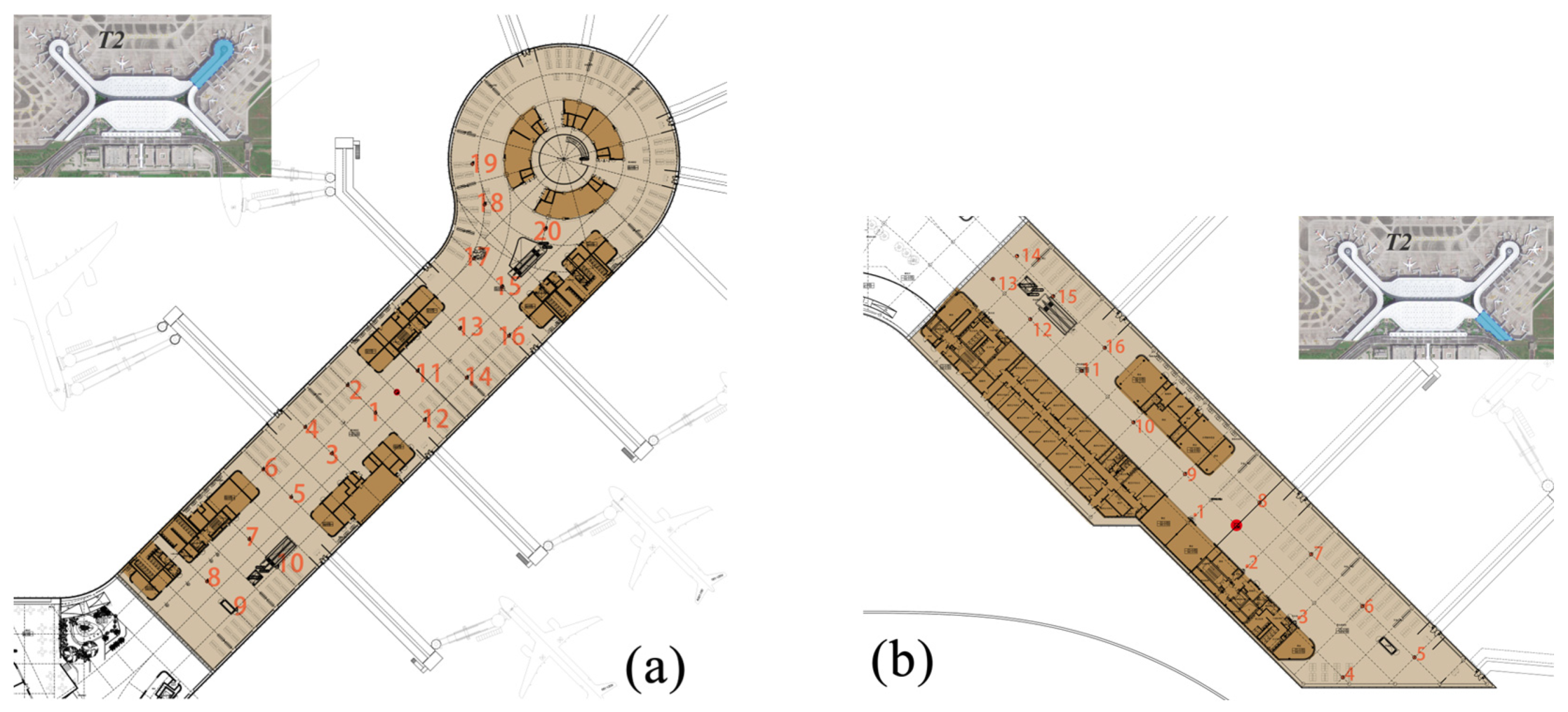
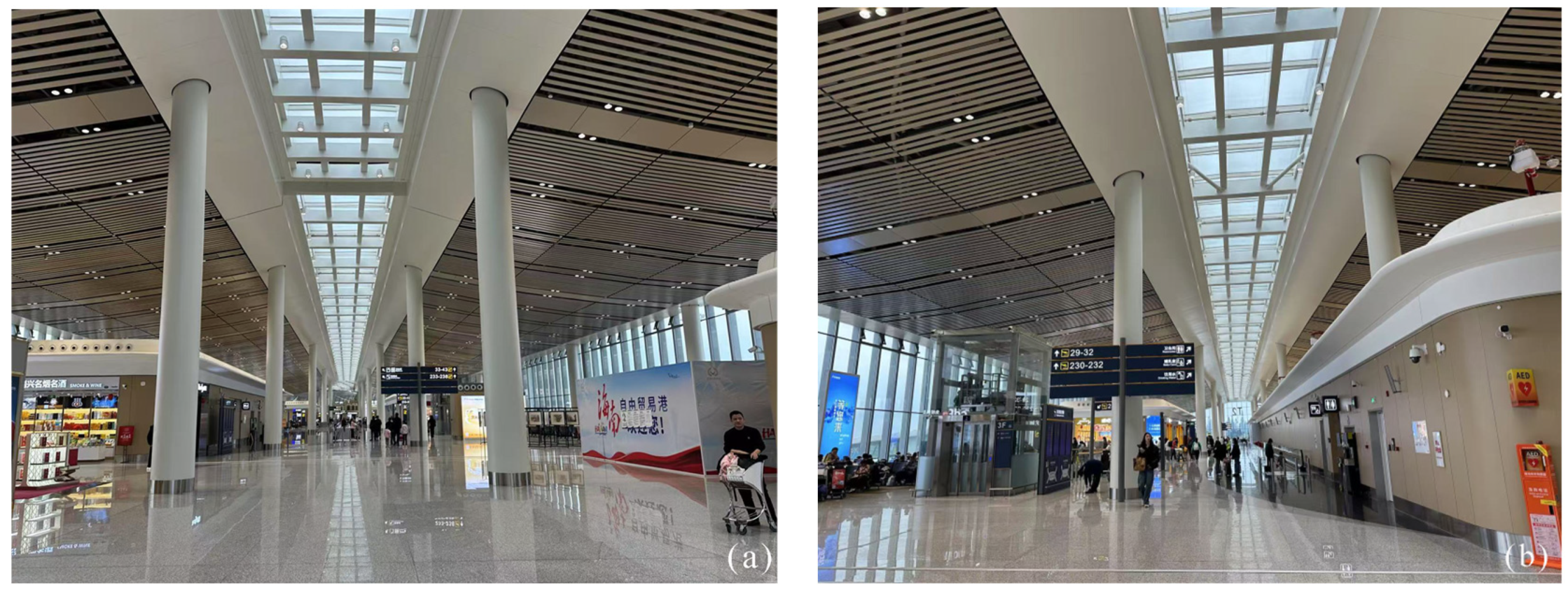
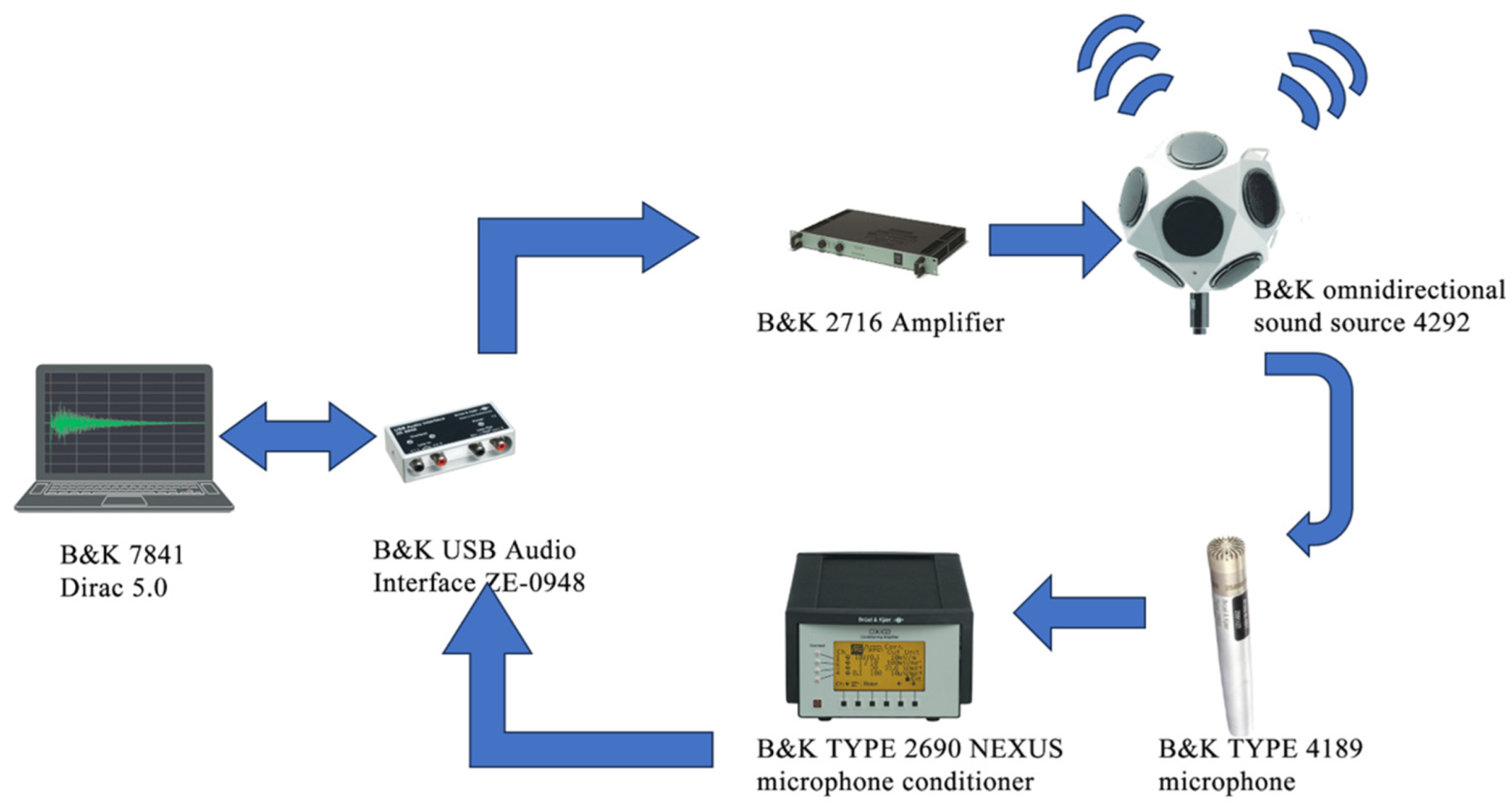
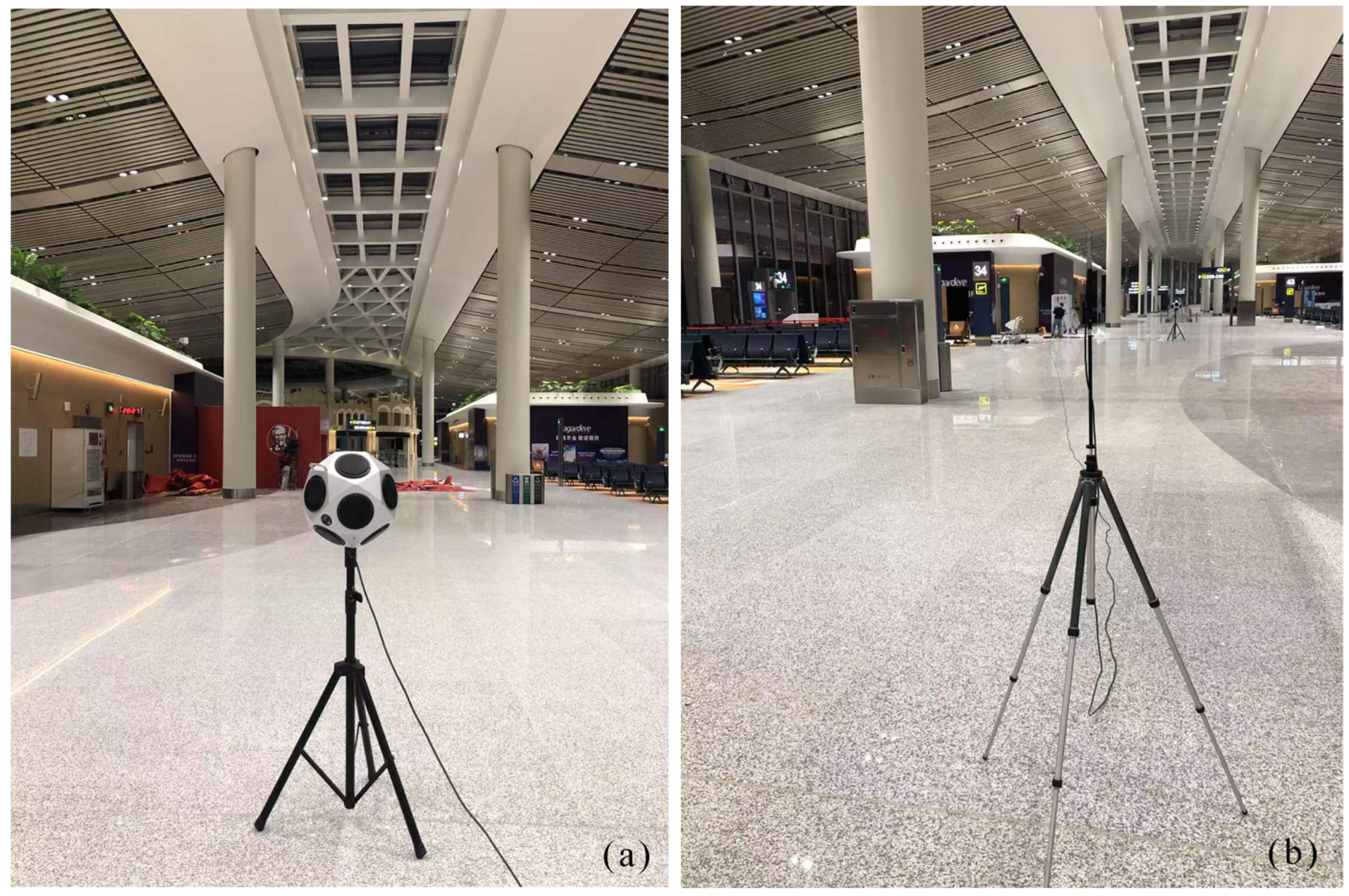
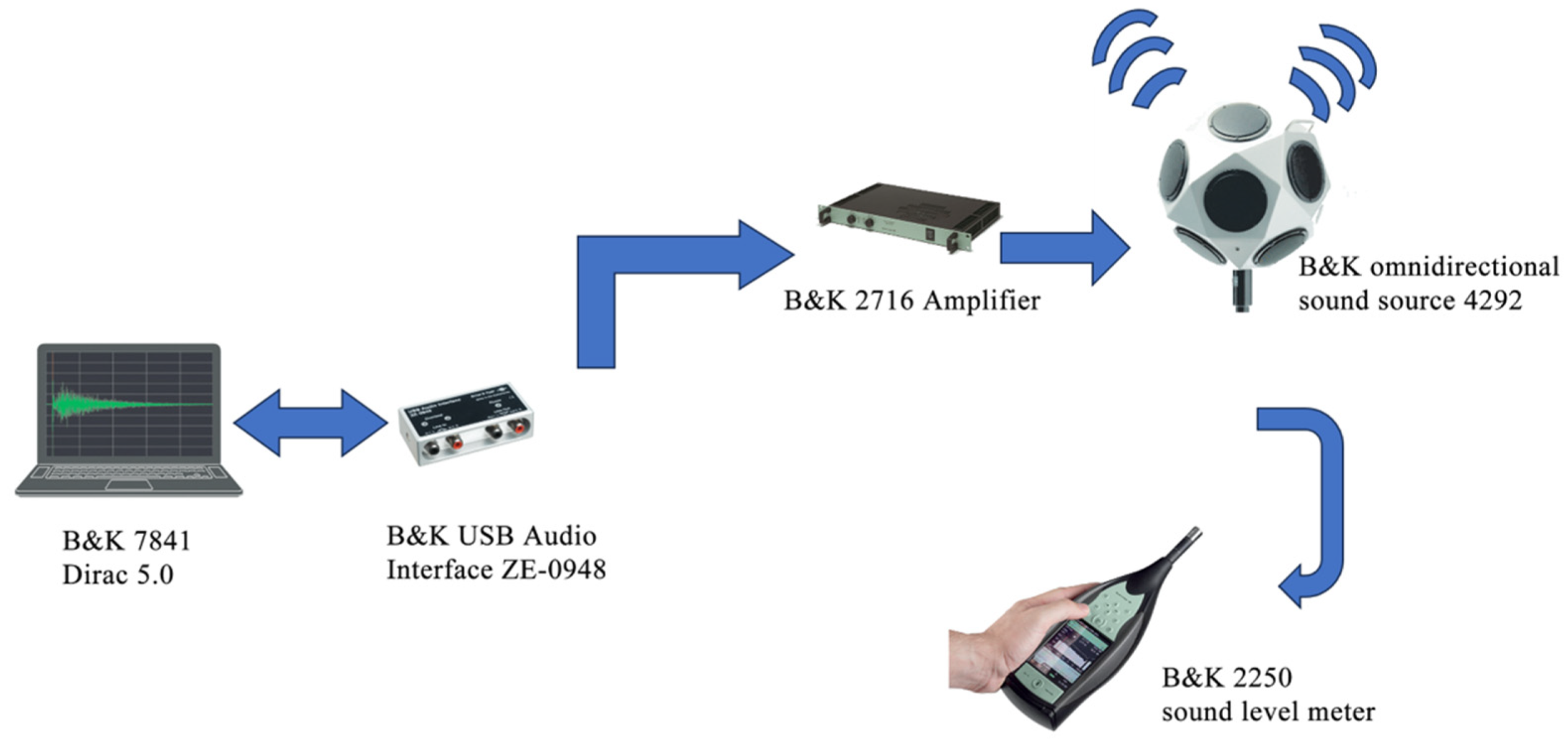




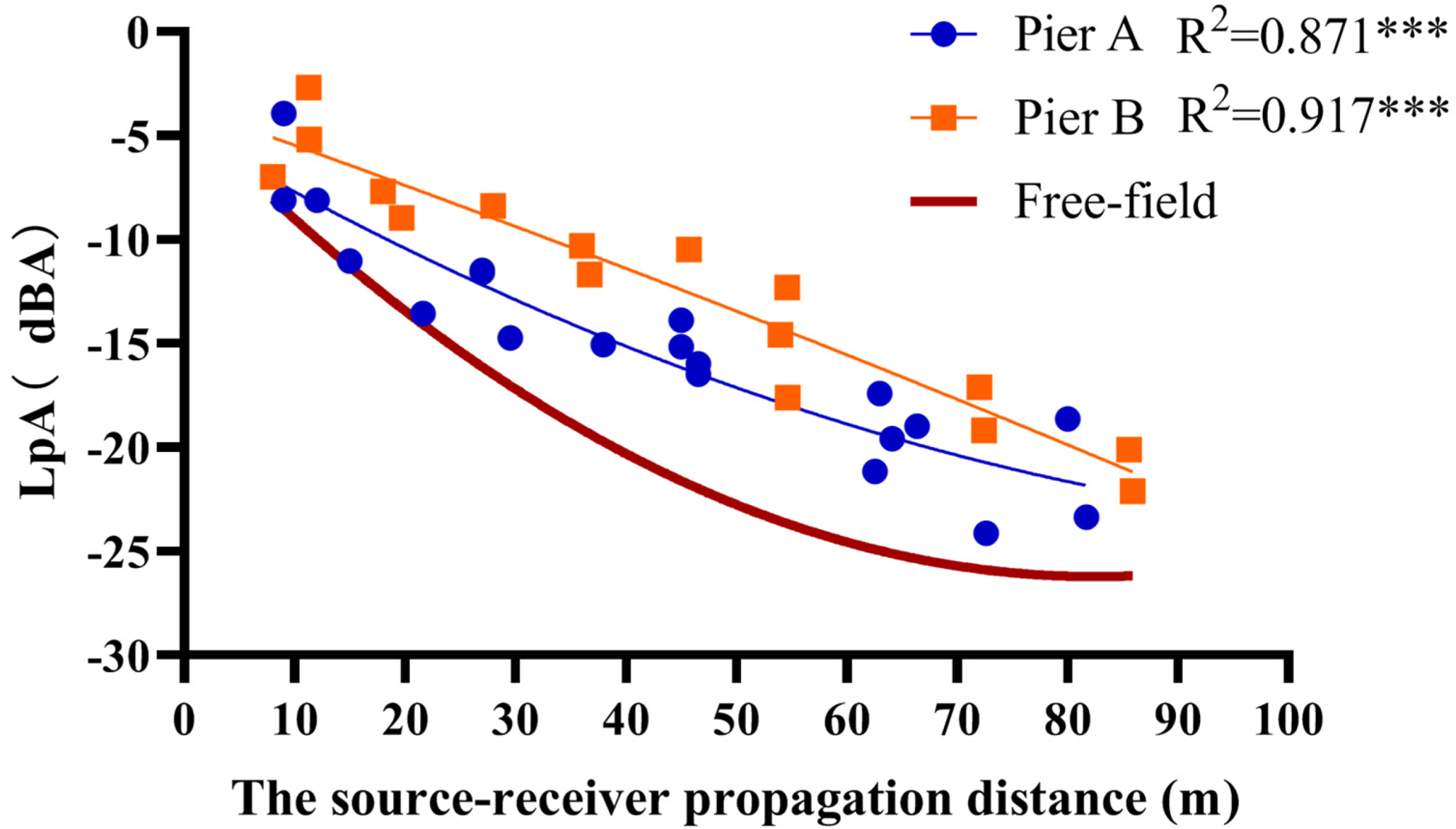
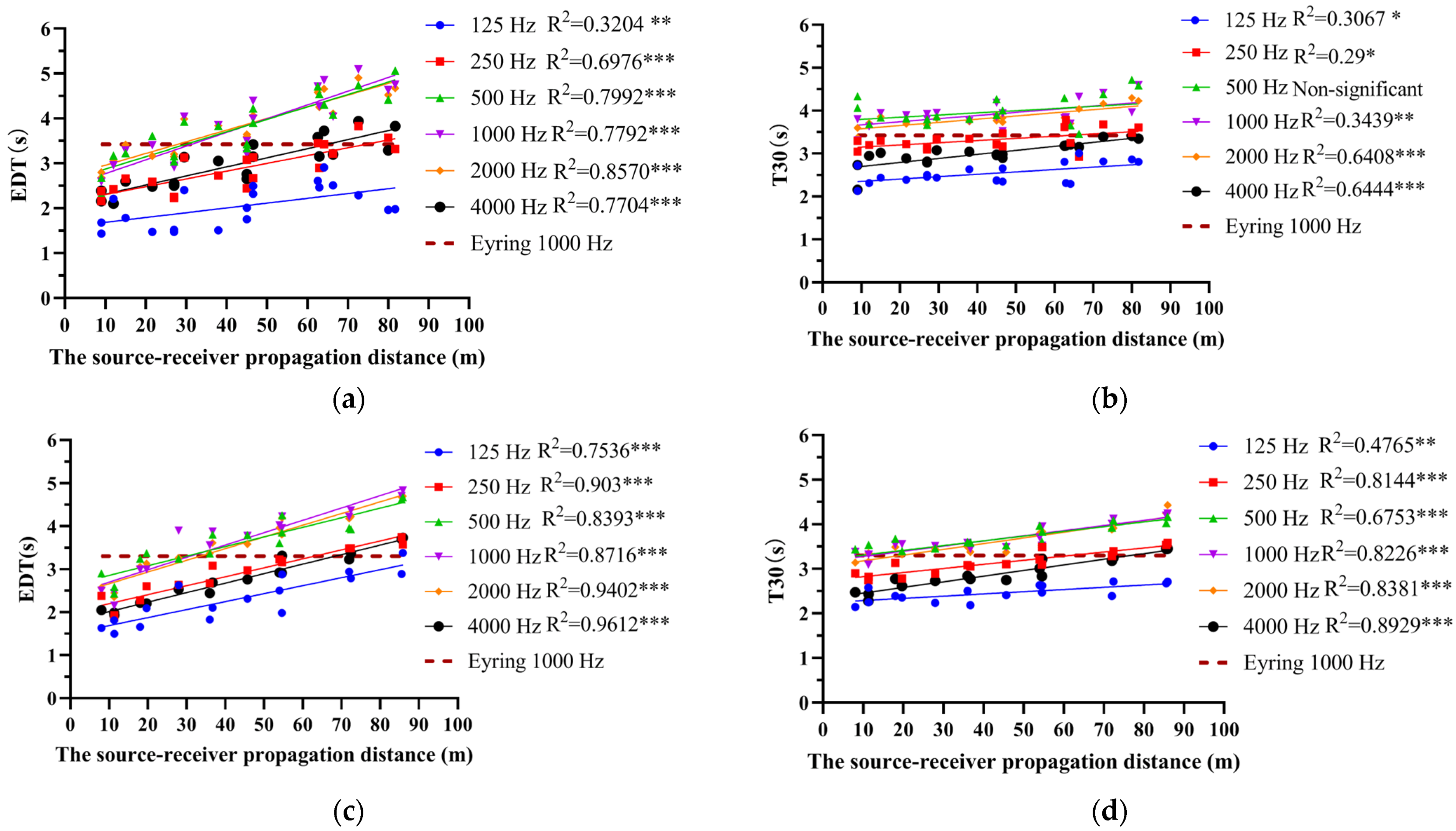
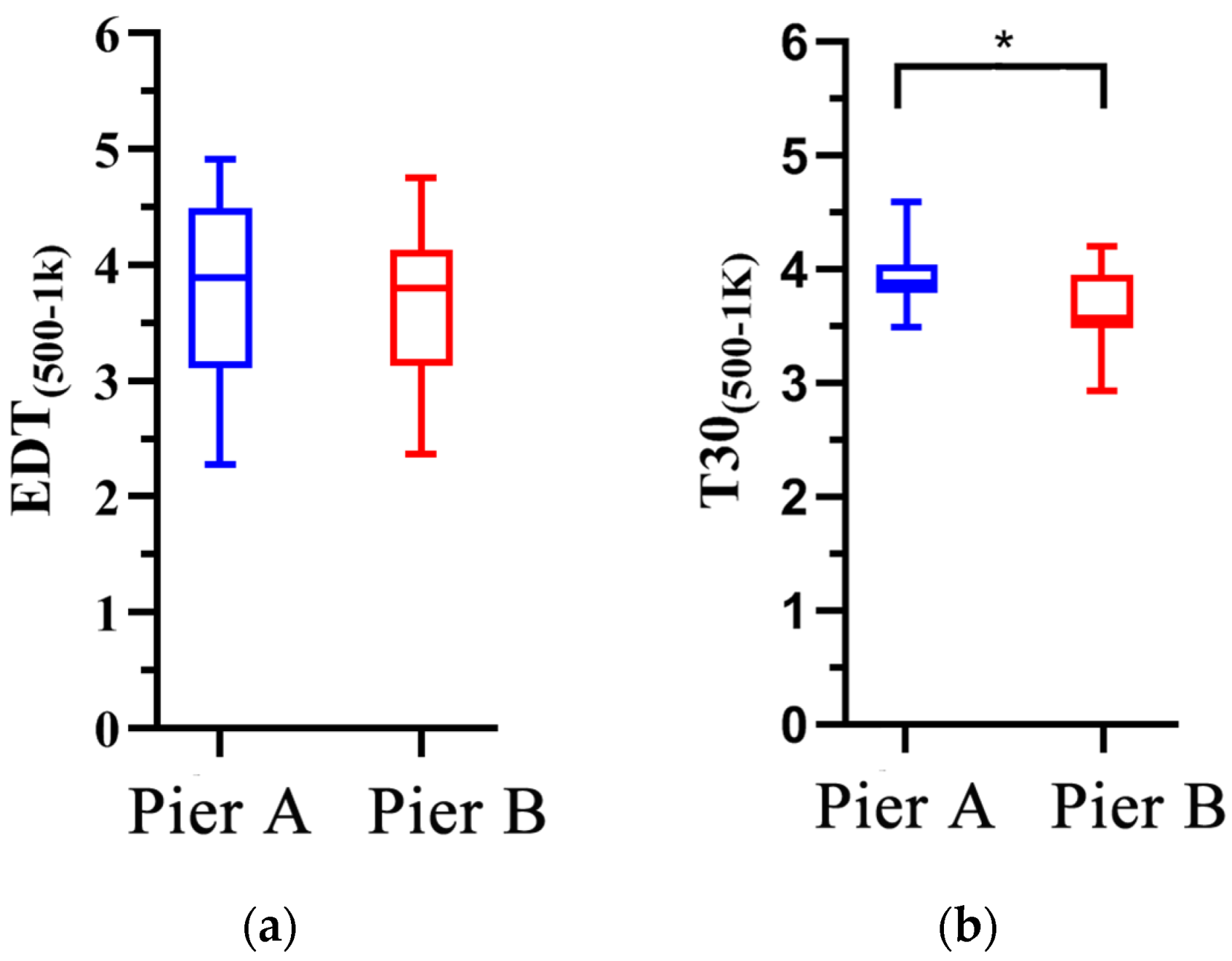


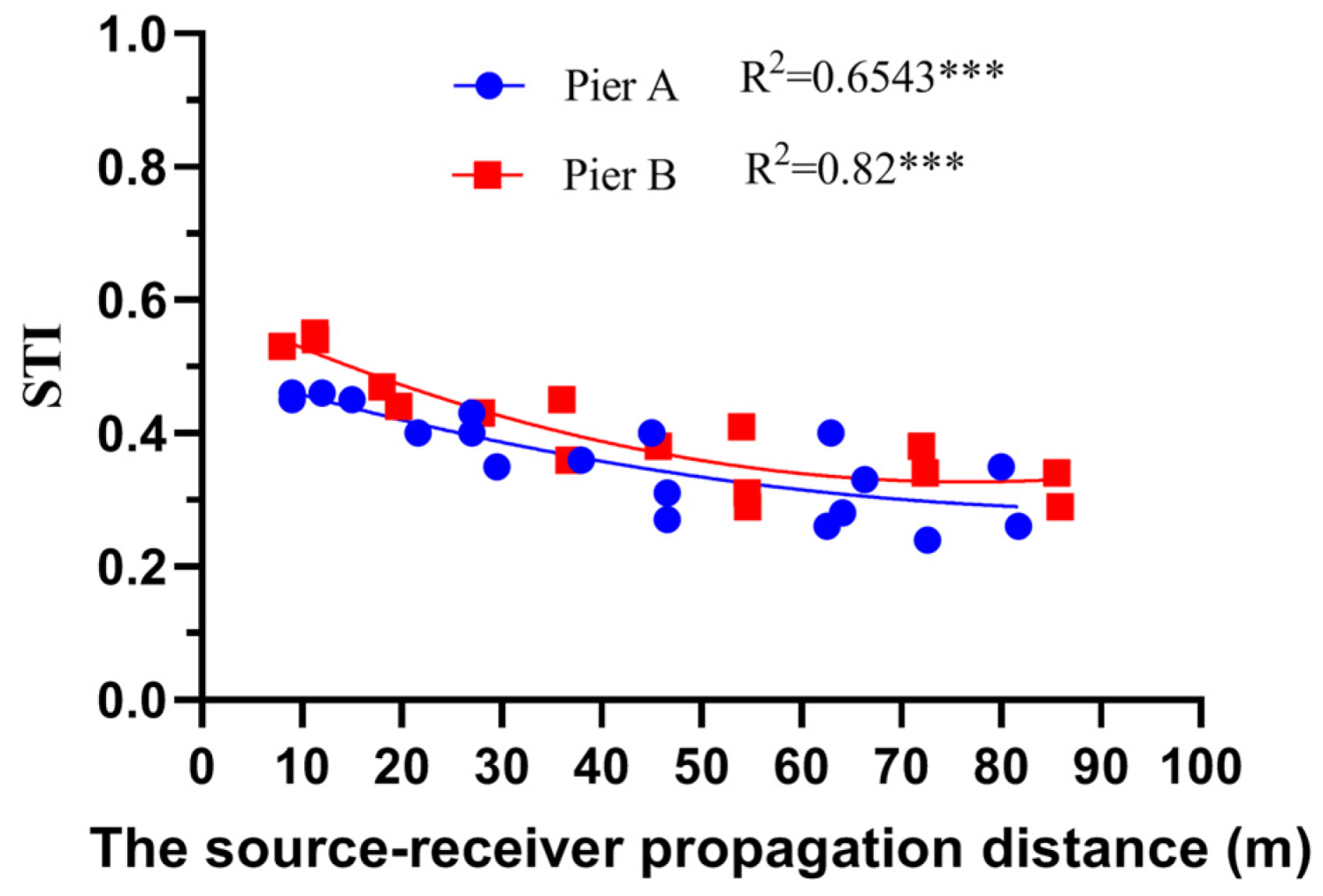
Disclaimer/Publisher’s Note: The statements, opinions and data contained in all publications are solely those of the individual author(s) and contributor(s) and not of MDPI and/or the editor(s). MDPI and/or the editor(s) disclaim responsibility for any injury to people or property resulting from any ideas, methods, instructions or products referred to in the content. |
© 2025 by the authors. Licensee MDPI, Basel, Switzerland. This article is an open access article distributed under the terms and conditions of the Creative Commons Attribution (CC BY) license (https://creativecommons.org/licenses/by/4.0/).
Share and Cite
Li, X.; Zhao, Y. Experimental Analysis of Sound Propagation and Room Acoustics in Airport Terminal Piers. Buildings 2025, 15, 915. https://doi.org/10.3390/buildings15060915
Li X, Zhao Y. Experimental Analysis of Sound Propagation and Room Acoustics in Airport Terminal Piers. Buildings. 2025; 15(6):915. https://doi.org/10.3390/buildings15060915
Chicago/Turabian StyleLi, Xi, and Yuezhe Zhao. 2025. "Experimental Analysis of Sound Propagation and Room Acoustics in Airport Terminal Piers" Buildings 15, no. 6: 915. https://doi.org/10.3390/buildings15060915
APA StyleLi, X., & Zhao, Y. (2025). Experimental Analysis of Sound Propagation and Room Acoustics in Airport Terminal Piers. Buildings, 15(6), 915. https://doi.org/10.3390/buildings15060915







